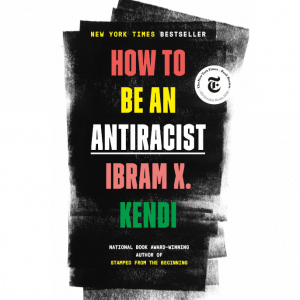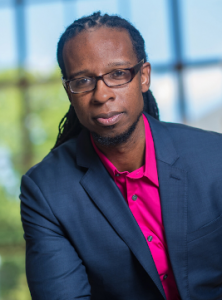Ibram X. Kendi, our campus’s 2021 Schoenfeldt Distinguished Writer, is a History professor at Boston University, founder of two Antiracist Research Centers, and the youngest-ever winner of the National Book Award for Nonfiction (for Stamped from the Beginning: The Definitive History of Racist Ideas in America). UP has chosen his bestseller How to Be an Antiracist as our “everybody reads” selection, which culminates in his March 31 campus presentation. Electronic copies of Kendi’s book can be accessed through the Clark Library here, and 400 paper copies will be available in early February to on-campus students, staff, and faculty.


Here in 2021, America’s pandemic of racism continues. Earlier this month, an armed white mob stormed the US Capitol to disrupt the transfer of power to a newly elected president who values antiracism. Part of the problem lies in our discourse. As former Attorney General Eric Holder once said, we are nation of cowards when it comes to talking about race. But courage and change can begin today, and this year’s ReadUP selection can help us hold more constructive conversations about racism’s toxic hierarchies.
Additionally, here at the beginning of a new semester, a number of ideas from Kendi’s book might assist our classes as we carry out UP’s stated mission to be “a place where diversity, equality, and inclusivity are paramount.” This essay gleans his strategies that apply to teaching: four promising ways we can take our varied curriculum toward the methods the book models. The four I explore invite us to:
I.) Rethink how we name things
II.) Envision goals through opposition
III.) Stay vigilantly self-aware
IV.) Trust that every one of your students has the potential to succeed
I.) One of Kendi’s strategies, which can be useful for whatever subject our courses pursue, is to rethink how we name those subjects. In his field of critical race theory, Kendi noticed how racism within ourselves can be hard for us – (all of us, regardless of race) – to see. Since we characteristically self-define with the phrase of denial “not racist” (and “[d]enial is the heartbeat of racism”), Kendi promotes the term “antiracist” (9). This word cultivates a more active stance, denying individuals the mirage of being neutral: at any given moment, our actions are either racist or antiracist. Similarly, he shifts the topic away from being applied to people’s hardened identities and toward actions and institutional policies: people or institutions cannot be inherently racist or antiracist, but their actions or policies at any moment can be (10). This rethinking of language and direction aims to unblock resistance to the subject – just as we might do in thinking through the characteristic resistance our students have toward our own discipline’s subjects.
Throughout Kendi’s book, we find him drawing upon this power of definition. Each chapter begins with a keyword defined in a concrete, simple, non-technical way. Thus readers are schooled in terms like antiracist (“[o]ne who is expressing the idea that racial groups are equals and none needs developing, and is supporting policy that reduces racial inequity”), activist (“[o]ne who has a record of power or policy change”) and class racist (“[o]ne who is racializing the classes, supporting policies of racial capitalism against those race-classes, and justifying them by racist ideas about those race-classes” (24, 201, 151).
Kendi subjects all terms of his field to scrutiny, finding that an increasingly popular phrase like “institutional racism” can blind us to the role of individuals in deflecting or creating change; he believes the phrase “racist policies” to be a better substitute due to its concrete delineation of power. These acts of defining are not trivial semantics, for “[d]efinitions anchor us in principles” (17). Defining can be part of reaching our goals, for as Kendi notes “the only way to undo racism is to constantly identify and describe it – and then dismantle it” (9). He models how by being innovative, strategic, concrete, and clear in the words we use to describe our discipline – rather than simply using the terms handed down to us by our field and our mentors – we can reduce our students’ resistance and cognitive load.
II.) Another pedagogical strategy instructors can draw from Kendi’s book is to envision our goals through opposition. As with rethinking the labels we use, this mode draws upon the power of concreteness to keep our thinking from becoming too abstract or inconsistent. When defining his phrases, he constantly sets them against an opposite. Thus he defines antiracism against racism, across a host of intersectional forms. For example, he clarifies that a racist policy is any measure that produces or sustains racial inequality between racial groups. An antiracist policy is any measure that produces or sustains racial equity between racial groups. By policy, I mean written and unwritten laws, rules, procedures, processes, regulations, and guidelines that govern people. (18)
As another example, in a chapter on sexuality, his definition of what “queer antiracism” is comes only after a definition of what “queer racism” looks like. Chapter by chapter, Kendi uses this pattern of opposition in defining racism’s existence in such things as biology, space, colorism, gender, culture, and ethnicity, using their racist forms to make clearer what their antiracist forms look like when successfully enacted.
Through Kendi’s use of opposition, I can see how far from his definition of “activist” I fall. For while my response to the events of 2020 led me to read a great many book on race (a response our colleague Alice Gates calls “cognitive binging”), I cannot point to any policies I helped change. And as Kendi notes, “Critiquing racism is not activism. Changing minds is not activism. An activist produces power and policy change, not mental change” (209). It turns out learning about antiracism might feel good, but change only happens through actively re-directing human and fiscal resources (210). My path forward is clear.
Kendi reveals his book’s most powerful interventions through many such overturnings. Replace racist policy with antiracist policy. Focus on policy change rather than mental change. Violent crime arises from unemployment, not race (79). The lingering problem of standardized test scores comes not from an “achievement gap” but from an “opportunity gap” (103). We should focus our attention on power instead of people, aiming to change policy instead of groups of people. And, as he shows by tracing racism’s origins in Europe’s capitalist efforts from the 1400s-1700s, racism arises not from human ignorance but from human self-interest: “[p]owerful economic, political, and cultural self-interest… has been behind racist policies” (43). The visualization enabled through oppositions open new channels of creativity – as we see in Kendi’s recognition that if racism’s powerful engine is self-interest, we might direct self-interest toward goals of antiracism. How might opposition clarify your curriculum’s most important interventions?
III. A third teaching strategy Kendi’s book models is to stay vigilantly self-aware, and to use this awareness as part of your curriculum. Books on policy can be painfully dry, but Kendi’s is a vivid work of creative writing, for every definition and lesson comes by way of autobiography. From his opening chapter (titled “My Racist Introduction”) to his final one (“Survival”), Kendi, who identifies as Black, notes how “Racist ideas fooled me my entire life,” and it took decades of living to learn to abandon his own racist ideas in favor of antiracist ones (227). In this assertion, he pushes back against many theorists who argue people of color cannot be racist.
Across each reflective, deeply personal chapter, Kendi makes himself vulnerable, revealing such moments as delivering prizewinning speeches as a teenager only to recognize later how they were built on racist assumptions, recognizing in his dating practices colorism (hierarchy according to the lightness or darkness of skin), learning to overcome homophobia in graduate school through the influence of peers, and redirecting his intellectual efforts toward policy change in the wake of murders about which he felt helpless (Trayvon Martin, Michael Brown). “Like fighting an addiction,” Kendi asserts, “being an antiracist requires persistent self-awareness, constant self-criticism, and regular self-examination” (23). The Acknowledgements section praises all the mentors who “put up mirrors that forced me to self-reflect” (240). Kendi’s autobiographical illustrations help build the case for readers that we, too, can change, through a similar process of increased self-awareness of causes and effects.
In our own classrooms, we can demonstrate a similar courage to make ourselves vulnerable before our students: to recruit the power and suction of storytelling; to illustrate our goals through our own young mistakes, to model paths forward. Additionally, we might take up Kendi’s challenge of self-awareness to ask: is what I’m doing now racist or antiracist? Am I hiding behind a mirage of neutrality? What of my lineup of readings? My lesson plan? This may not depend so much upon our discipline itself (e.g. differential equations) as our attitudes in deploying the subject.
The dividends of such a strategy will not only include increased student attention and engagement, but also some unexpected connections. In a final chapter, Kendi finds himself bringing up the dramatic events of dealing with cancer diagnoses in his wife, his mother, and even himself (stage four colon cancer). He finds he cannot help but link the diseases of racism and cancer (“What if we treated racism in the way we treat cancer?”), and discovers a way to illustrate the high stakes involved in confronting both: [t]he popular conception of denial – like the popular strategy of suasion – is suicidal” (237, 235). No matter how dry we might think our course subjects are, Kendi shows the power of the personal can help bring it alive.
IV.) Lastly, How to Be an Antiracist reminds us that every one of our students has the potential to succeed. We cannot afford to write off anyone, no matter their grades or group identities, or perceived hierarchies. Just as Kendi asserts there are no “racists” – only racist acts and policies, he insists on humanity’s capacity for change: “I used to be racist most of the time. I am changing” (10).
Kendi himself hated high school and had poor grades: he “tuned out teachers like they were bad commercials” (92). After all, some harassing teachers “saw my Black body not as a plant to be cultivated but as a weed to be plucked out of their school and thrown into their prison” (82). In part because other teachers chose not to treat him this way, Kendi went on to earn a doctorate, win the National Book Award, and become one of today’s most important cultural influences.
As teachers, we work within an allegedly meritocratic system. But we should remember the pattern Kendi points to in defining that order: “Whoever creates the cultural standard usually puts himself at the top of the hierarchy” (91). We cannot mistake these constructed hierarchies as a measure of students’ potential or humanity. As it is racist to regard any of our students as “race representatives” and to “racialize behavior,” we should patrol our regard for them as individuals and throw out false hierarchies. Kendi reminds us we can approach our often-misguided students not with “ideological attacks” but with “firm hugs tailored to each student’s experience, compelling self-reflection” (218). He asks, “[w]hat if we realized that the best way to ensure an effective educational system is not by standardizing our curricula and tests but by standardizing the opportunities available to all students?” (103).
Just as President Fr. Poorman asserts that “each student is a universe of possibilities,” Kendi reminds us that the horizontal – rather than vertical – view is the most humane one: “This book is ultimately about the basic struggle we’re all in, the struggle to be fully human and to see that others are fully human” (11). Our regard for all students in the classroom will help us move closer to this essential goal.